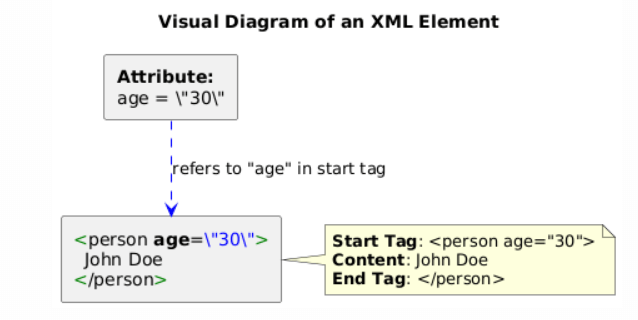XML Attributes and Values: Adding Depth to Your Data
Welcome back, XML enthusiasts! We’ve just explored how to define XML tags to structure your data. Now, let’s learn how to add even more detail and specific information to your elements using attributes and their values. Think of attributes as sticky notes that provide extra context or properties about an element.
What Are XML Attributes?
An XML attribute is a piece of information that describes a specific property or characteristic of an XML element. Attributes are always placed within the start tag of an element, and they consist of a name-value pair. They provide metadata—data about the data—that often helps to identify or qualify an element.
For example, consider a <student> element. You might want to include information like their ID number or whether they are currently active. These pieces of information are perfect candidates for attributes:
<student id="BTECH101" status="active">...</student>
Here, id and status are attribute names, and "BTECH101" and "active" are their respective values. Attributes are generally used for non-structural, descriptive information.
Essential Rules for XML Attributes and Their Values
Just like with tags, there are strict rules for using attributes to ensure your XML document remains well-formed and parsable:
- Attribute Values Must Be Quoted: This rule is non-negotiable! Every attribute value, whether it’s a number, a string, or a boolean, must be enclosed in either single (
') or double (") quotation marks. This helps parsers clearly identify the start and end of the value.- Correct:
<product price="500.00">Laptop</product> - Incorrect:
<product price=500.00>Laptop</product> - Reason: Without quotes, the parser wouldn’t know where the value ends.
- Correct:
- No Attribute Minimization: Unlike some older HTML practices, attributes cannot be “minimized” in XML. This means you cannot just write the attribute name if it signifies a true/false state. You must explicitly provide a value.
- Correct:
<checkbox checked="checked" /> - Incorrect:
<checkbox checked /> - Reason: This ensures clarity and consistency, which are hallmarks of XML.
- Correct:
- Unique Attributes within an Element: An element cannot have two attributes with the exact same name. Each attribute within a single element must be unique.
- Correct:
<user id="1" type="admin">...</user> - Incorrect:
<user id="1" id="2">...</user> - Reason: Duplicating attribute names would create ambiguity for the parser.
- Correct:
- Attribute Names are Case-Sensitive: Just like element names, attribute names are also case-sensitive.
IDis different fromid. Consistency is key here to avoid errors.
Elements vs. Attributes: When to Use Which?
This is a common question for beginners! While both elements and attributes store data, their typical use cases differ:
- Use Elements When:
- The data is part of the document’s core structure.
- The data contains multiple sub-components (e.g., a
<person>element might have<first_name>and<last_name>as children). - The data needs to be easily extensible or frequently queried.
- The data contains mixed content (text and other elements).
- For example, a book’s
<title>or an article’s<body>.
- Use Attributes When:
- The data is metadata about the element, rather than content itself.
- The data is simple, atomic (a single value), and does not require complex structure.
- The data helps to uniquely identify the element (like an ID).
- For example, an element’s
idor a product’sstatus.
Example Comparison:
Consider representing information about a student.
Using Elements (Generally Preferred for Core Data):
<student>
<id>BTECH202</id>
<name>Priya Sharma</name>
<email>priya.s@example.com</email>
</student>
Using Attributes (For Metadata):
<student id="BTECH202" name="Priya Sharma" email="priya.s@example.com" />
While the second example is valid, if “name” and “email” might later need their own sub-elements (e.g., separate first name/last name, multiple emails), using elements for them from the start is more flexible.
Ultimately, both elements and attributes are crucial for creating descriptive XML documents. Understanding their distinct roles and applying the correct syntax ensures your XML data is well-organized, readable, and perfectly suited for processing by any XML-aware application.
